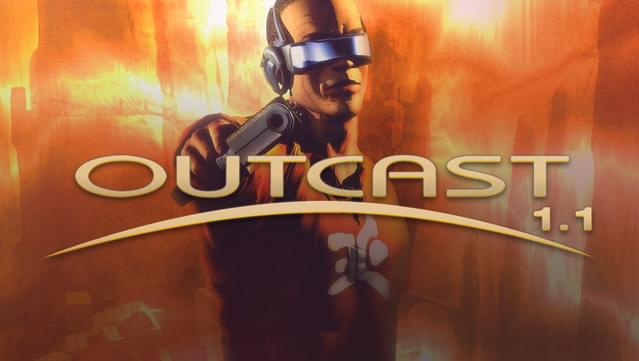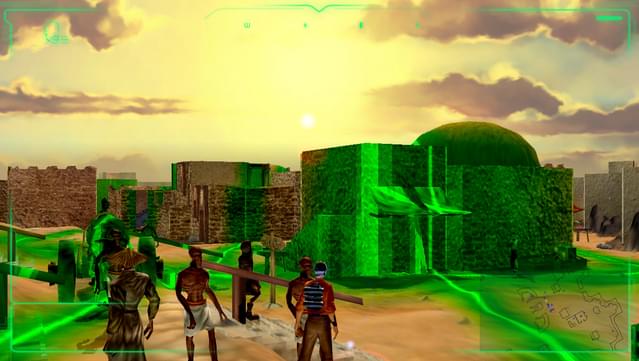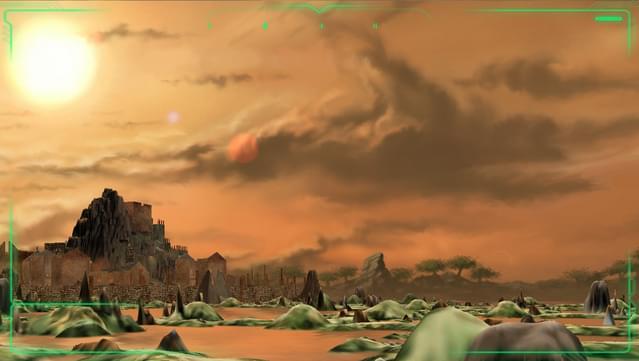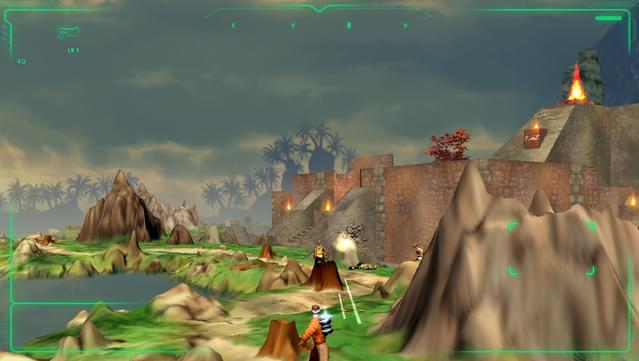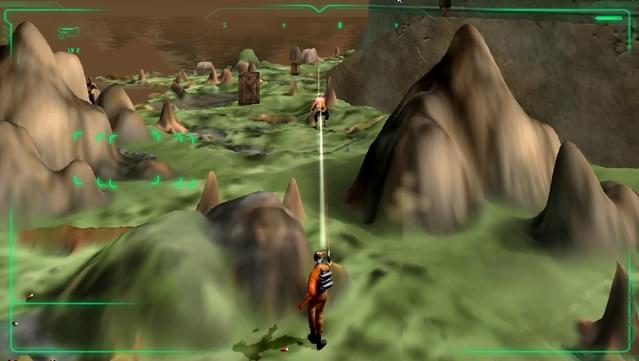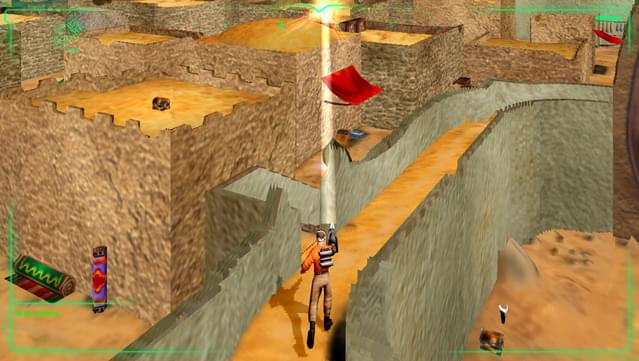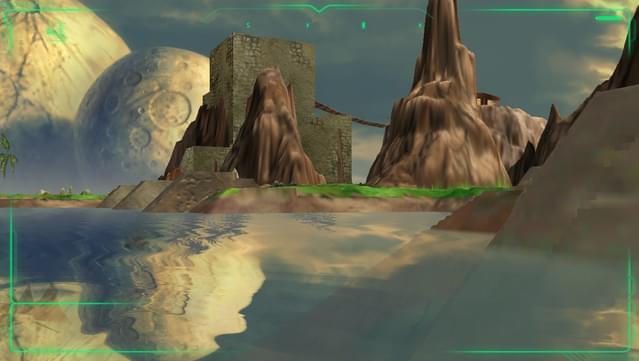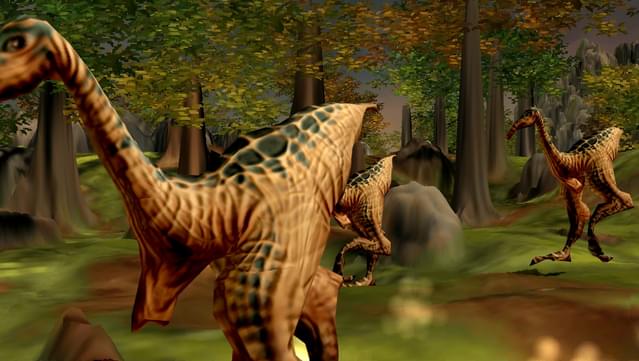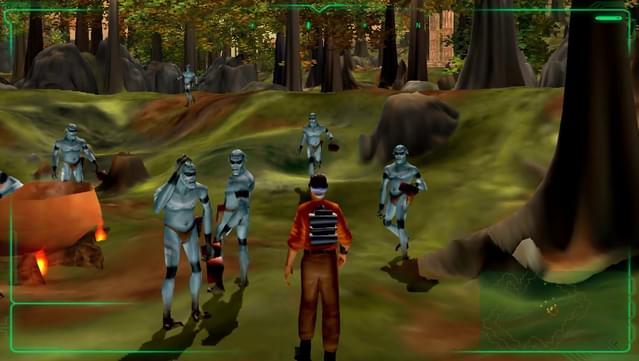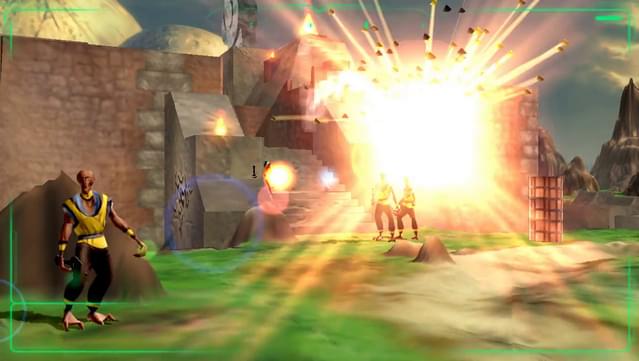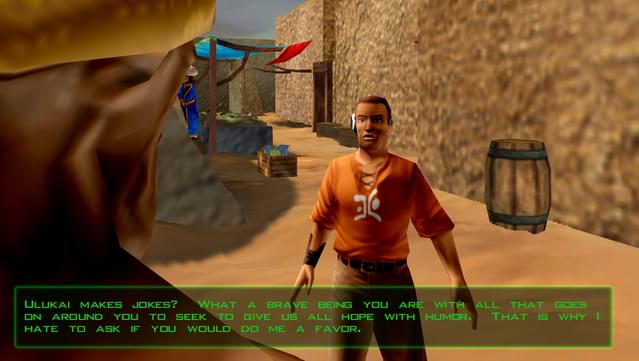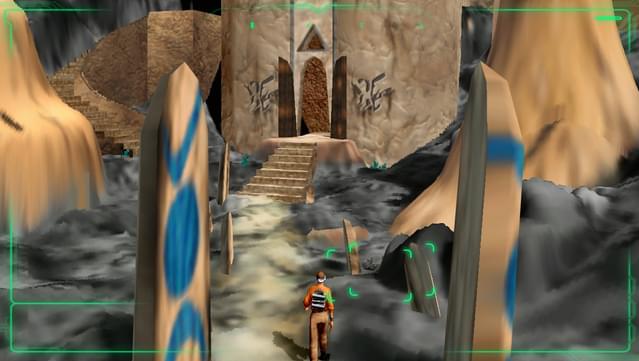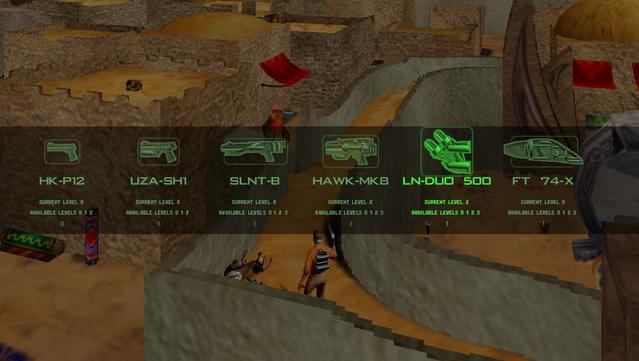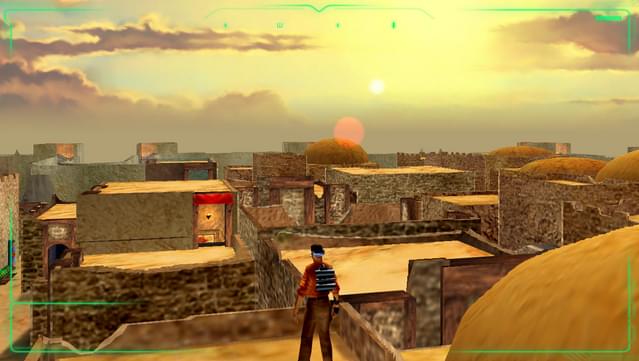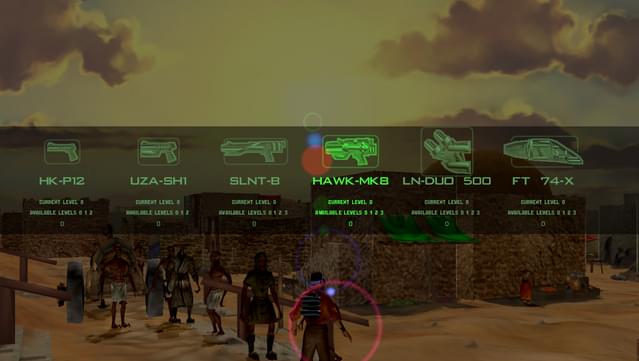Posted on: January 15, 2011

Curunauth
Verified ownerGames: 1226 Reviews: 23
An open, living, genre-defying world of fun
A quick tip: head to the forums and pick up _Zenger_'s hi-res pack, along with Entropy and Muskie's .INI tweaks (I've listed both in Entropy's "List your .INI Tweaks" thread). The game can look really quite nice if you push it! [It will also fix an important and common bug you may encounter in one mission due to your computer being a lot faster than was possible in 1999.] VISUALS: This game is very unusual on the visual front. The landscapes are often gorgeously designed, the architecture is varied and attractive, and much of the texture work is excellent . . . but the innovative voxel rendering engine built to allow long draw distances and fast loading of complex terrain also results in huge blocky cells and unfortunate jagged edges in lots of places. The resolution and level of detail limits also conceal a lot of the underlying goodness. Fortunately, you can see everything in maximum glory by downloading _Zenger_'s hi-res pack from the forums and applying Muskie and Entropy's .INI tweaks, which will jack up the draw distance and level of detail to maximum, letting you see the best the game has to offer. It still isn't up to modern standards, but the character models look good, and the rough, varied terrain really does look nice and add to the game's feel. The low-res terrain textures and blockiness around edges are acceptable tradeoffs to get the organic terrain, and the water looks really nice. Character design is quite good, and while there are only a few basic character models for the various everyday inhabitants of major cities, there is still a solid feel of bustling city life full of distinct individuals. Good use of color helps here, as do the variety of buildings and the loose city layout. Overall, I wouldn't call Outcast a visually stunning experience, but it is certainly visually interesting and it sure has its moments. SOUND: I don't usually have a sound section, but it is worth noting that Outcast has excellent sound, especially for its time. Cities bustle, natural areas are populated with wildlife, everything you walk on sounds like it should, and the music is just right. The dynamic soundtrack appropriately fades combat and danger themes in and out as appropriate, which really adds to times when you take a few too many hits and desperately run and try to hide in back alleys and rooftops. Perhaps most importantly, every one of the huge cast of characters is voiced, and distinctively so. The actual voice acting is pretty good, despite the occasional silliness of the writing; everyone has a distinct personality and really sounds the part. STORY/ACTING: Outcast's greatest strength is the level of engagement with the world around you. All of the interlinked areas are populated by a surprising number of NPCs, and many missions you undertake are interlinked in a way that makes the world feel more alive and natural. Sure, underneath, the structure is often "solve A, B, and C's problems so they'll help D, enabling you to fix a conflict with E, which opens up a route to complete a mission objective" so common to adventure titles . . . but it doesn't *feel* that way. It helps that those and the many optional (but often profitable and always fun) sidequests offered by the many many other characters you meet are all unique, rather than a collection of fetch quests and monster hunts. You never think about formulas because they never rise to the surface; you just meet a lot of people with problems, and you help them. Furthermore, the problems are realistic - the autocrat you are trying to overthrow has imposed many restrictions that legitimately prevent citizens from attending to critical tasks that you can manage, thanks to the freedom of movement provided by your guns. Furthermore, the world feels even more alive when you notice that your actions have lasting effects - not only will people treat you differently depending on how you behave, but when you convince leaders to help the resistance, the enemy troops will be appropriately affected. On the note of guns and enemy troops, combat works into the story and gameplay more naturally than many "action-adventure" titles. You're participating in a resistance movement, so you'll encounter and have to deal with or evade patrols. Eventually you'll have the firepower to take on garrisons, after which you'll have a lot fewer local patrols to deal with. Wild animals roam the land, and you'll usually see or hear them in time to decide whether to take the long way or share some high-velocity presents. You can't just shoot everything though - your guns don't work in water, and there are nasties of various sorts that need to be avoided in various ways. (Or you can waste some dynamite. Outcast's openness usually provides multiple options, and blowing things up is always a fun one!!) It never feels like any enemy is artificial - you fight (or evade) when you need to do something that would naturally put you at odds with something dangerous . . . which may include walking about occupied territory, given that they *are* hunting for you! There are almost no limitations on your movement - even "blocked off" areas can sometimes be entered if you're clever about it, and you can roam all over the world and use any inter-area portal at any time. But as an early character warns you, you'd be wise to avoid, say, jumping into a soldier camp before you're a bit geared up. You can certainly sneak around dangerous areas in cities before you're ready to confront the guards, but you'd better keep on your toes when you do! All this freedom of movement again contributes to the feeling of a real, living world rather than a structured adventure game composed of a set of quests. You will spend a lot of time interacting with a huge cast, but the game helpfully keeps notes of who wants what done, hints you've received, things you've taken care of, helpful information about the different areas of the world, and a running glossary of alien terms. You can chat with nearly every passer-by, and they can be rather helpful when you're trying to locate someone. Amazingly, even with such a huge set of data, it never feels overdone or too much - it's just a world you're in, full of people worth meeting. Some are quite amusing; a particular interaction you might miss is talking to the music players in the bar-type buildings. Other characters with whom you have to work are jerks; I disliked a few enough to actually boycott them while they still had useful stuff! CONTROLS and GAMEPLAY: You have a pretty standard FPS-like control set, jump and prone/crawl controls, and a couple action buttons. Your inventory is accessed by a menu (that helpfully pauses the game), and you have weapon hotkeys. Actions are somewhat context-sensitive in a way that never caused any problems. You can smoothly flip between first and third person perspective in any situation (and first-person twon-ha riding looks just right!), and both work nicely. You'll probably want to be in first person most of the time in combat, although you can definitely aim reasonably in third person. As soon as you can afford it, buy a twon-ha: not only is it a much faster way to get around, but it also lets you dispense with stairs a lot of the time. Mounted combat is also a lot of fun. Unfortunately, it won't cross water, so unless you can find some way to obtain a local mount, you'll be without your trusty steed in some areas. A lot of time is spent talking, and you use a menu to select topics of conversation, as well as occasionally getting the chance to choose a response (usually yes/no to a request). There is one occasion where you get to sing along if you know the words . . . and it's rather funny when you don't (or when you do, actually). You can also shop, either purchasing supplies or getting some consumables made from raw materials you collect. Fortunately, there is no need to grind collecting, as you'll happen upon plenty of stuff as you explore; you do have to think about how to spend it on various types of ammo. On the note of ammo, you start with 1 gun and can eventually acquire a total of 6, with two upgrades for most. All guns and upgrades to all but one are purchased, so you'll need to do some questing to afford good gear. One set of upgrades comes from items that are acquired in one of the more amusing and enjoyable missions. Depending on how you like to play, you might favor any of the weapons, so give 'em all a spin. DIFFICULTY: Combat is not particularly hard, thanks to slow projectiles on all sides. That said, you can still be overwhelmed if you're not careful, and even if they don't initially spot you, enemies will return fire from most ranges, and will advance on your position once alerted. In fact, the AI is surprisingly good, occasionally employing flanking tactics and pincer maneuvers, as well as intelligently seeking cover and dodging fire. This makes combat reasonably fun even if it isn't usually all that challenging (at least once you gear up). If you want, you can tweak the .INI files to speed up enemy projectiles or increase the damage you take; there are ample health-boosting items to find, which I only used two or three times. There is a bug due to the vast speed increases in modern processors that will block you from completing one important mission [the last jump at the lighthouse becomes impossible to make]; as mentioned before, _Zenger_'s patch fixes this issue, or you can briefly enable a cheat via the hidden developer console, which has no in-game penalty. Other than that, none of the puzzles are terribly hard, although some of them take a bit of thinking, which is nice! If you talk to everyone about your problems, you will get ample hints, although some enterprising NPCs will charge you for their help. There is one very mild platforming section that becomes exciting when the physics engine surprises you halfway through . . . but it's still pretty simple. The part immediately following that takes some careful walking and well-timed running, but it's not too bad. A few puzzles require a bit of simple physics use to solve, which was fun even if it felt a touch tech-demo-y. LEVELS, STRATEGY, and OTHER ELEMENTS: As I've mentioned repeatedly, the level design is great - lush forests, scenic vistas, lively cities, and fun puzzles. The big levels and huge casts aren't a problem thanks to the possibility of asking anyone you meet where they last saw any named character. Unfortunately, the cast in the main city is so large that some characters will be off the menu until you ask about a couple others to cycle the choices. This is pretty much the only significant complaint I had at any point in the game, and it was entirely surmountable. Memorable characters and the helpful district signs along the main city road are generally guide enough, and you can use the ever-so-handy teleport devices to mark important characters to whom you expect to return. I really liked a few of the game elements that played fairly minor roles, most especially the Sannegtas - anything that forces a change-up of tactics is nice. Each island has its own unique feel, and even though there aren't many enemy types, the AI is good enough that attacking each fortification plays differently, depending on your approach and the lay of the land. The story kept things moving, and nothing ever got to the point of feeling stale. THE VERDICT: Outcast feels like the developers set out not to create any particular game, but to build a world, populate it, and then they found a place for you that lets you explore, experience, and participate in its story. With a few tweaks, it looks fine, it still sounds good, and the story is engaging, cliches and all, thanks to good acting and a cast of dozens that make everything come to life. For building and maintaining an immersive experience, and for clean, varied, and frustration-free gaming, Outcast earns a well-deserved 5/5. No matter what you like in games, at $6 you have no excuse not to try this out!
Is this helpful to you?
